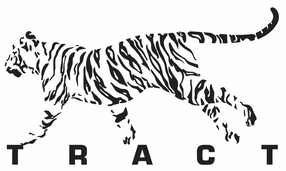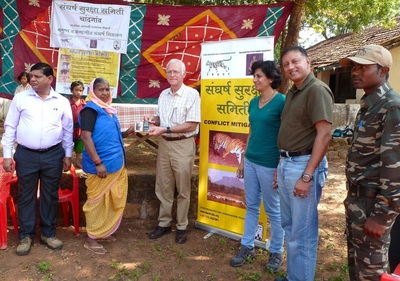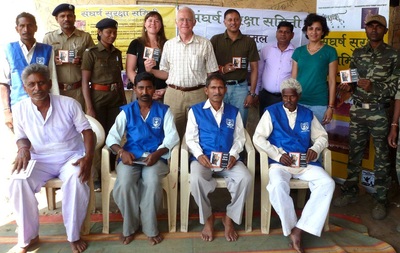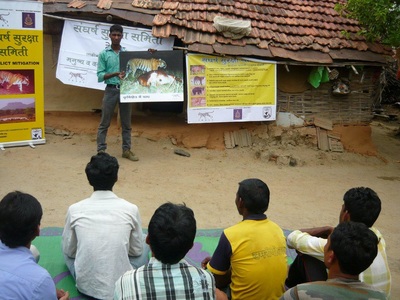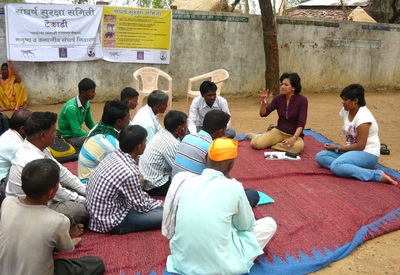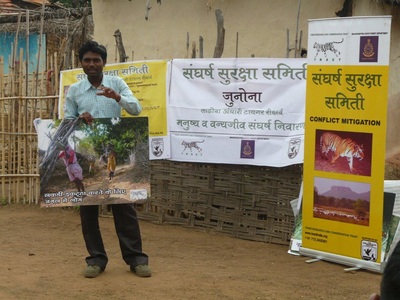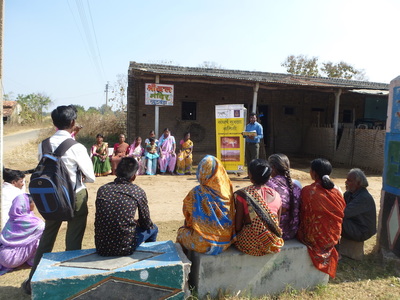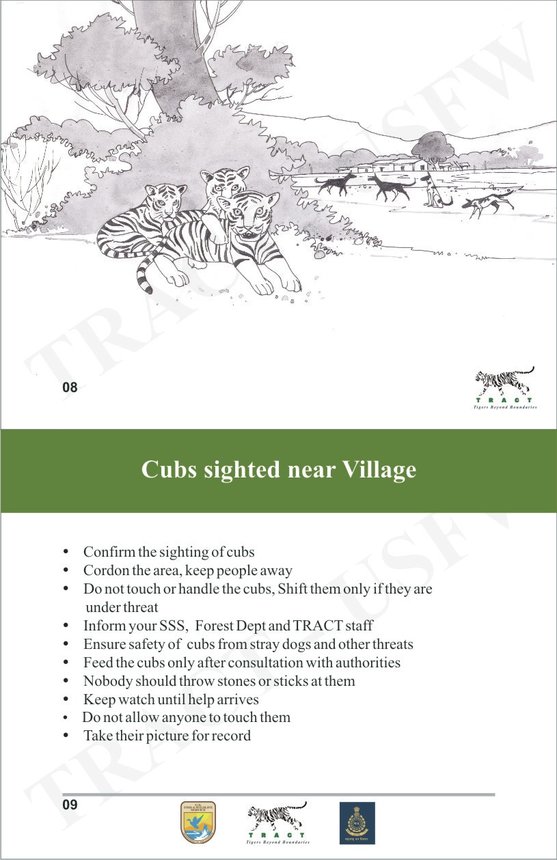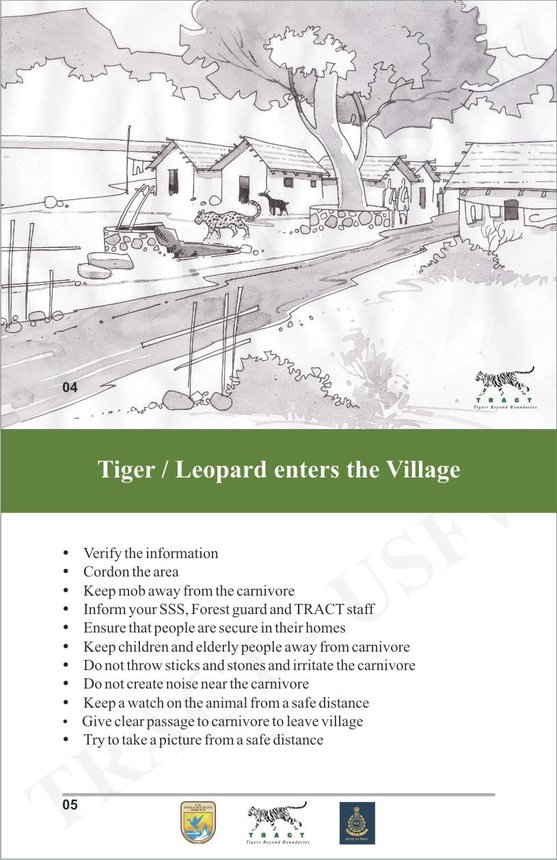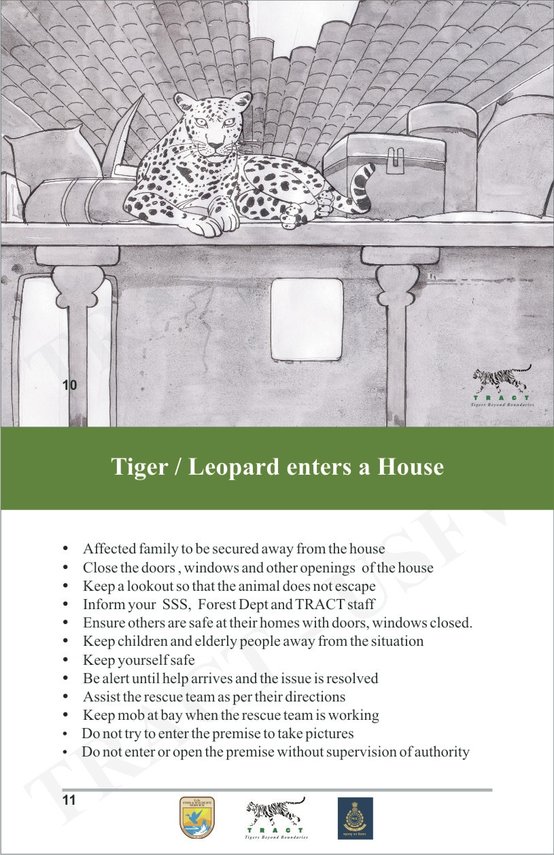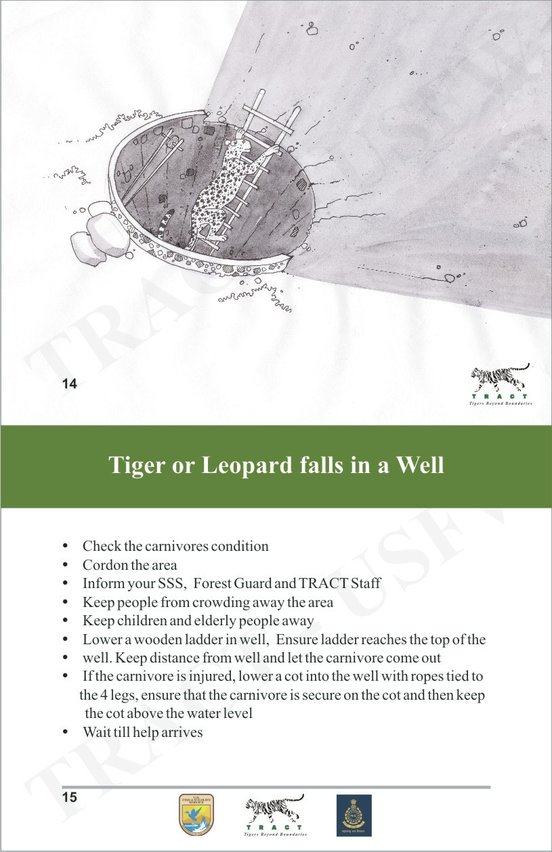- About Us
-
Our Work
-
Our Projects
>
- Integrated Habitat Conservation and Eco Development
- Village Social Transformation
- Community Leadership for Conflict Mitigation
- Tiger Ambassadors - Satpuda Landscape Tiger Partnership
- Securing Women - Daksh Nari
- Tiger Conservation - Satpuda Landscape Tiger Partnership
- Human Wildlife Conflict- Mitigation
- Community for Tigers
- Jungle Patrols
- Consolidation of Habitat
- Training and Workshops
- Gallery
- Concepts
- Initiatives
- Reports
-
Our Projects
>
- Get Involved
- Media
Community Leadership For Conflict Mitigation
SUPPORTED BY U.S FISH AND WILDLIFE SERVICES & WILDLIFE CONSERVATION NETWORK
Education and Awareness in Local Communities for Mitigation of Human – Tiger/Leopard Conflict - Primary Response Teams
Creating a network of 600 local leaders as 1st responders to Conflict in 84 villages in the Buffer area of Tadoba Andhari Tiger Reserve and its forested corridors with the skills and knowledge to resolve human – tiger / leopard conflict in the region and to create an Early Warning system to minimise threats of attack.
With the support of and in partnership with US Fish and Wildlife Services, TRACT commenced the Conflict mitigation in 82 villages situated in the Buffer of Tadoba Andhari Tiger Reserve in 2013. This initial two year program received a very positive response form the communities and this concept of Primary response teams was a successful model with participation of local communities for mitigation. As a continuous hand holding with the communities was crucial for the success of this effort, USFWS extended their support and we have continued this work with the local communities in this landscape.
We have been working towards understanding reasons for human - tiger / leopard conflict in human dominated forest fringes and for mitigating measures for the same. Study of the high conflict between people and large carnivores 'Large Carnivore Attacks on Humans in Central India: A Case Study from the Tadoba Andhari Tiger Reserve' by Dhanwatey et al. 2013, states that most of the attacks on people by large carnivore took place in forest areas, while victims were in a crouching position collecting firewood or other forest produce, or were attending to natures call squatting near the bush.
The program takes the learnings from this decade long study to the ground, sharing this information with the locals who live here and the forest staff that govern these forests.
Primary Response Teams (PRT's), a group of 7 men and women in 84 villages in the buffer and forested corridors of Tadoba Andhari Tiger Reserve, Chandrapur district have been selected for their motivation and keenness to volunteer, to work towards reducing their vulnerability to attacks by tigers, leopards and sloth bears. Empowered with information about reasons for conflict and their role in reducing their vulnerability to attacks, these local leaders have learnt about the code of conduct for individuals and norms for villages that will reduce circumstances which lure large carnivores closer to their precincts. It is their responsibility to disseminate this information to their families and other community members.
This program has also created a Platform for dialogue between these primary response team members (local leaders) and the local forest guard to share information about presence of tigers, leopards or sloth bear near villages and fields, thereby extending this information to the community to make them alert to the threat of conflict if they venture into the forest.
This Early Warning System has helped in people knowing about presence and avoiding these thickets. TRACT staff have on many occasions helped children and women to get home safely.
We have also created a First Line of Defence / 1st responders in these leaders by bringing them on the same page as the local forest guard through educative workshops about their behaviour and that of their community during a conflict situation, to ensure that they work as a team with the forest staff, mitigating with no harm to them or the wild animal in case of such an eventuality.
TRACT has made a Manual in the local language for these leaders, with illustration that carries all information about the code of conduct for individual, circumstances that lure tigers and leopards closer to village precincts and how these should be avoided.
Prior to working with the communtiies, TRACT designed and implemented the Corridor Conservation Program (2008-2011) supported by the National Tiger Conservation Authority for mitigating of human - large carnivore conflict, TRACT in collaboration with the Maharashtra State Forest Department has trained more than 400 forest field personnel working in the forest fringes and forested corridors of Chandrapur Circle, where conflict between humans and large carnivores has been alarmingly high. Workshops for understanding reasons for conflict, monitoring of large carnivores, handling of Camera traps and GPS units, identifying threats to tigers and leopards in forest fringes and forested corridors were conducted by TRACT followed by recommendations for mitigation.
Creating a network of 600 local leaders as 1st responders to Conflict in 84 villages in the Buffer area of Tadoba Andhari Tiger Reserve and its forested corridors with the skills and knowledge to resolve human – tiger / leopard conflict in the region and to create an Early Warning system to minimise threats of attack.
With the support of and in partnership with US Fish and Wildlife Services, TRACT commenced the Conflict mitigation in 82 villages situated in the Buffer of Tadoba Andhari Tiger Reserve in 2013. This initial two year program received a very positive response form the communities and this concept of Primary response teams was a successful model with participation of local communities for mitigation. As a continuous hand holding with the communities was crucial for the success of this effort, USFWS extended their support and we have continued this work with the local communities in this landscape.
We have been working towards understanding reasons for human - tiger / leopard conflict in human dominated forest fringes and for mitigating measures for the same. Study of the high conflict between people and large carnivores 'Large Carnivore Attacks on Humans in Central India: A Case Study from the Tadoba Andhari Tiger Reserve' by Dhanwatey et al. 2013, states that most of the attacks on people by large carnivore took place in forest areas, while victims were in a crouching position collecting firewood or other forest produce, or were attending to natures call squatting near the bush.
The program takes the learnings from this decade long study to the ground, sharing this information with the locals who live here and the forest staff that govern these forests.
Primary Response Teams (PRT's), a group of 7 men and women in 84 villages in the buffer and forested corridors of Tadoba Andhari Tiger Reserve, Chandrapur district have been selected for their motivation and keenness to volunteer, to work towards reducing their vulnerability to attacks by tigers, leopards and sloth bears. Empowered with information about reasons for conflict and their role in reducing their vulnerability to attacks, these local leaders have learnt about the code of conduct for individuals and norms for villages that will reduce circumstances which lure large carnivores closer to their precincts. It is their responsibility to disseminate this information to their families and other community members.
This program has also created a Platform for dialogue between these primary response team members (local leaders) and the local forest guard to share information about presence of tigers, leopards or sloth bear near villages and fields, thereby extending this information to the community to make them alert to the threat of conflict if they venture into the forest.
This Early Warning System has helped in people knowing about presence and avoiding these thickets. TRACT staff have on many occasions helped children and women to get home safely.
We have also created a First Line of Defence / 1st responders in these leaders by bringing them on the same page as the local forest guard through educative workshops about their behaviour and that of their community during a conflict situation, to ensure that they work as a team with the forest staff, mitigating with no harm to them or the wild animal in case of such an eventuality.
TRACT has made a Manual in the local language for these leaders, with illustration that carries all information about the code of conduct for individual, circumstances that lure tigers and leopards closer to village precincts and how these should be avoided.
Prior to working with the communtiies, TRACT designed and implemented the Corridor Conservation Program (2008-2011) supported by the National Tiger Conservation Authority for mitigating of human - large carnivore conflict, TRACT in collaboration with the Maharashtra State Forest Department has trained more than 400 forest field personnel working in the forest fringes and forested corridors of Chandrapur Circle, where conflict between humans and large carnivores has been alarmingly high. Workshops for understanding reasons for conflict, monitoring of large carnivores, handling of Camera traps and GPS units, identifying threats to tigers and leopards in forest fringes and forested corridors were conducted by TRACT followed by recommendations for mitigation.
Pictures above are of the training workshops of the Primary Response Teams called the 'Sangharsh Suraksha Samiti's in 84 villages
Manuals distributed by Mr. Fred Bagley and Ms. Cory Brown of USFWS
Pages of the Manual for the Primary response teams below:
Manuals distributed by Mr. Fred Bagley and Ms. Cory Brown of USFWS
Pages of the Manual for the Primary response teams below:
